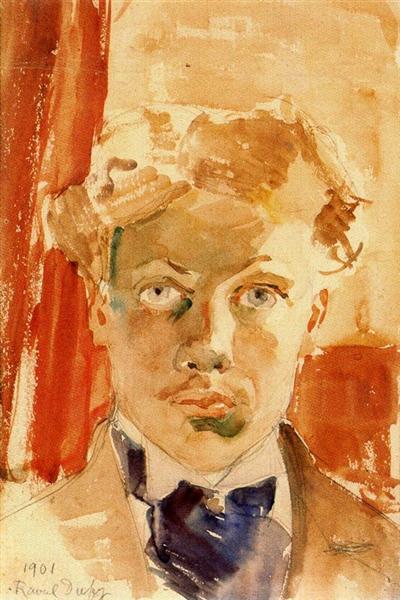In the early 20th century, art became more individualistic, with artists adopting new distinct styles and approaches to their works. Movements such as Expressionism and Fauvism sprung out of this era and influenced many artists to freely express themselves through their art. This included Raoul Dufy, a Fauvist French painter who created elegant and carefree artwork throughout his career.
Although little information about the artist’s early life is known, Dufy was born and raised in Le Havre, France, in the late 1800s. Later on in his life, he obtained a scholarship in 1900 to travel to Paris and study at the art school, École des Beaux-Arts. Here he began creating his early pieces with an impressionistic approach, but his style soon changed in 1905 after meeting Fauvist painter Matisse and other painters in this style. Dufy began dabbling into Fauvism and further gained inspiration after viewing the works of Paul Cezanne during his visit to the 1907 exhibition. He was drawn to Cezanne’s use of colours and compositions, which led him to begin incorporating those elements into his works, using softer tones and more structured compositions. Dufy continued experimenting with Fauvism and Cubism for the next two years until he fell back into Fauvism with his carefree approach.
While Dufy was a successful painter, he was also well crafted in other mediums. He was a highly skilled artist creating pieces like woodcut illustrations for poets, crafting designs for textile companies while also producing ceramics and tapestries. It wasn’t until the 1920s that he decided to focus solely on painting.

Dufy’s style comprises bright colours painted over a white ground to enhance its richness and figures painted in a sketch-like way with outlines on his subjects. Because of this approach, his paintings were often criticized for looking superficial and too carefree, but I think these elements drew me into his work. I am not a huge fan of the loose quality present in most fauvist paintings, as it can sometimes look messy, but Dufy’s work stood out to me in particular because of his use of graphic lines and soft colours. I think his technique in crafting his work helps organize the visuals and information better, and I believe he executes that well with his pieces.


Despite the criticism Dufy faced with his work, he built a reputable name by 1925 and was commissioned by many to paint murals on buildings and work on other projects. He continued to paint and work until his death in 1953 due to arthritis.
Sources:
“Raoul Dufy Biography.” Masterworks Fine Art Gallery, https://www.masterworksfineart.com/artists/raoul-dufy/biography.
“Raoul Dufy.” Encyclopædia Britannica, Encyclopædia Britannica, Inc., https://www.britannica.com/biography/Raoul-Dufy.
Header Image: https://www.wikiart.org/en/raoul-dufy/self-portrait-1901

Leave a Reply